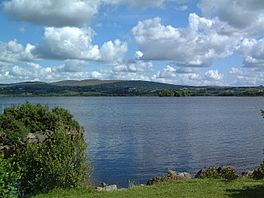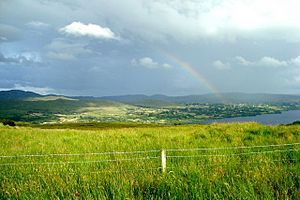Lough Eske facts for kids
Quick facts for kids Lough Eske |
|
|---|---|

Looking east
|
|
| Location | County Donegal |
| Coordinates | 54°41′59″N 8°02′24″W / 54.6996°N 8.0399°W |
| Native name | Loch Iascaigh Error {{native name checker}}: parameter value is malformed (help) |
| Primary inflows | Clashalbin River, Lowerymore River, Corabber River, Clady Burn |
| Primary outflows | River Eske |
| Basin countries | Ireland |
| Max. length | maximum of 3.7 km (2.3 mi) |
| Max. width | maximum of 2 km (1.2 mi) |
| Surface area | 900 acres (3.6 km2) |
| Surface elevation | 27 m (89 ft) |
| Islands | Pigeon's Island, Grania's Island, Island O'Donnell, Roshin Island |
| Settlements | Donegal (nearest town) |
Lough Eske (pronounced 'Loch Esk') is a beautiful, small lake in County Donegal, located in the west of Ireland. Its name comes from the Irish words "Loch Iascaigh," which means "Lake of the Fish." The lake is found northeast of Donegal Town and is connected to it by the River Eske. It covers about 900 acres (3.6 square kilometers) and is surrounded by the impressive Blue Stack Mountains to the north, east, and west.
Contents
Fun Things to Do at Lough Eske
Lough Eske and its rivers are popular for fishing. People especially enjoy catching spring salmon, sea trout, and char. The fishing season runs from March 1st to September 30th.
Because of its lovely and untouched natural beauty, the lake is a popular place for a relaxing trip. There are two big hotels right on its shores.
The area also has many forest paths perfect for walking. You can find paths on the southwestern side of the lake. There are also newly fixed-up paths in Ardnamona Wood.
A Look at Lough Eske's Past
Lough Eske has a long and interesting history, with stories of powerful clans, religious groups, and grand castles.
Ancient Castles and Clans
The strong Ó Domhnaill (O'Donnell) family once had a castle and a protective wall, called a bawn, on Island O'Donnell. This island is close to the southern shore of the lake. Part of this old wall can still be seen today. The Ó Domhnaill leaders often used this castle as a prison.
The Franciscan Friars
After the Franciscan Friary in Donegal Town was burned in September 1601, the friars (religious brothers) had to escape. They set up a new friary on the western shores of Lough Eske. This gave the name 'The Friary' to a local area and 'Friar's Walk' to a path along the lake.
The friars stayed near the lake for most of the next hundred years. However, a special order in August 1687 told all Catholic clergy to leave Ireland. This was a big blow to the friars in Donegal. They had often been forced to leave their home and it was attacked many times due to political problems between the English and Irish leaders.
Around the time of this order, the friars were believed to be living near the lake again. They were close to Barnesmore Gap on the east shore, near Roshin Island. This island is thought to have been used as a graveyard by the friars. You can still see signs of graves there today.
The Brooke Family and Lough Eske Castle
After an event called the Flight of the Earls in 1607, the land in this part of Donegal was given to Sir Basil Brooke. He rebuilt and made Donegal Castle bigger. Around the same time, a large house, called a manor, was built on the shores of Lough Eske by Scottish settlers. A stone from this manor had the date 1621 carved into it.
In the early 1800s, the Brooke family's land went to Thomas Young through marriage. He changed his name to Thomas Brooke. In 1846, Thomas first built a new church, Christ Church, on the southern shore of the lake. Later, he hired an architect to completely redesign the manor house. The result was a grand Elizabethan-style home, finished in 1868, which became known as Lough Eske Castle.
The White Family at the Castle
Major-General Henry George White bought Lough Eske Castle in 1894. After he passed away in 1906, his son, Henry Herbert Ronald White, and his wife, Florence Arnott White, moved in. Florence was the daughter of Sir John Arnott, who started Arnott's Department Store in Dublin. He also owned The Irish Times newspaper.
Major-General Henry George White is buried at Lough Eske Castle. A large, beautiful Celtic cross marks his grave near the lake. He was a kind landowner who was well-liked by the local Irish people. He was known for helping others and giving money to Christ Church.
In 1911, Henry Herbert Ronald White and his wife added more rooms to the castle, including a ballroom and a billiards room. After 1929, the castle became a guest house. In 1939, after Major Henry Herbert Ronald White's sudden death, the castle almost completely burned down because of a candle left burning. The castle was eventually sold and became a guest house again before falling into ruins.
Lough Eske Castle Today
In the early 2000s, the castle was rebuilt and reopened as the Solis Lough Eske Hotel in December 2007. The church built in 1846 is still used as the local Church of Ireland church today.
A 'Famine Pot' from a local workhouse is now on the shores of the lake. This pot was used during the Great Famine in the 1840s and 1850s. It stands as a reminder of all the local people who died or had to leave Ireland during that difficult time.
The 'Lough Eske Monster' Story
In July 1998, a newspaper called the Irish Daily Star published a story titled ‘Look out, it's Eskie’. It claimed that a 'monster' had been seen in the lake! Staff and guests at Harvey's Point Hotel told the reporter that on June 28, 1998, they saw something unknown moving about 300 meters from the shore.
Other local people, like bed and breakfast owners Annabel and Kieran Clarke, shared some local folklore. They said that 'some lakes in County Donegal are connected by currents to Scotland'. They were trying to link it to the much more famous Loch Ness Monster.
Some people thought the Lough Eske Monster was just a trick to get attention for the local Donegal Summer Festival. However, Zack Gallagher, who was in charge of the festival, has always said he believes such a creature exists. After this, the idea of a monster in Lough Eske wasn't talked about much. Some people think it might have just been a lost seal that swam up the River Eske from Donegal Bay.
See also
 In Spanish: Lago Eske para niños
In Spanish: Lago Eske para niños




